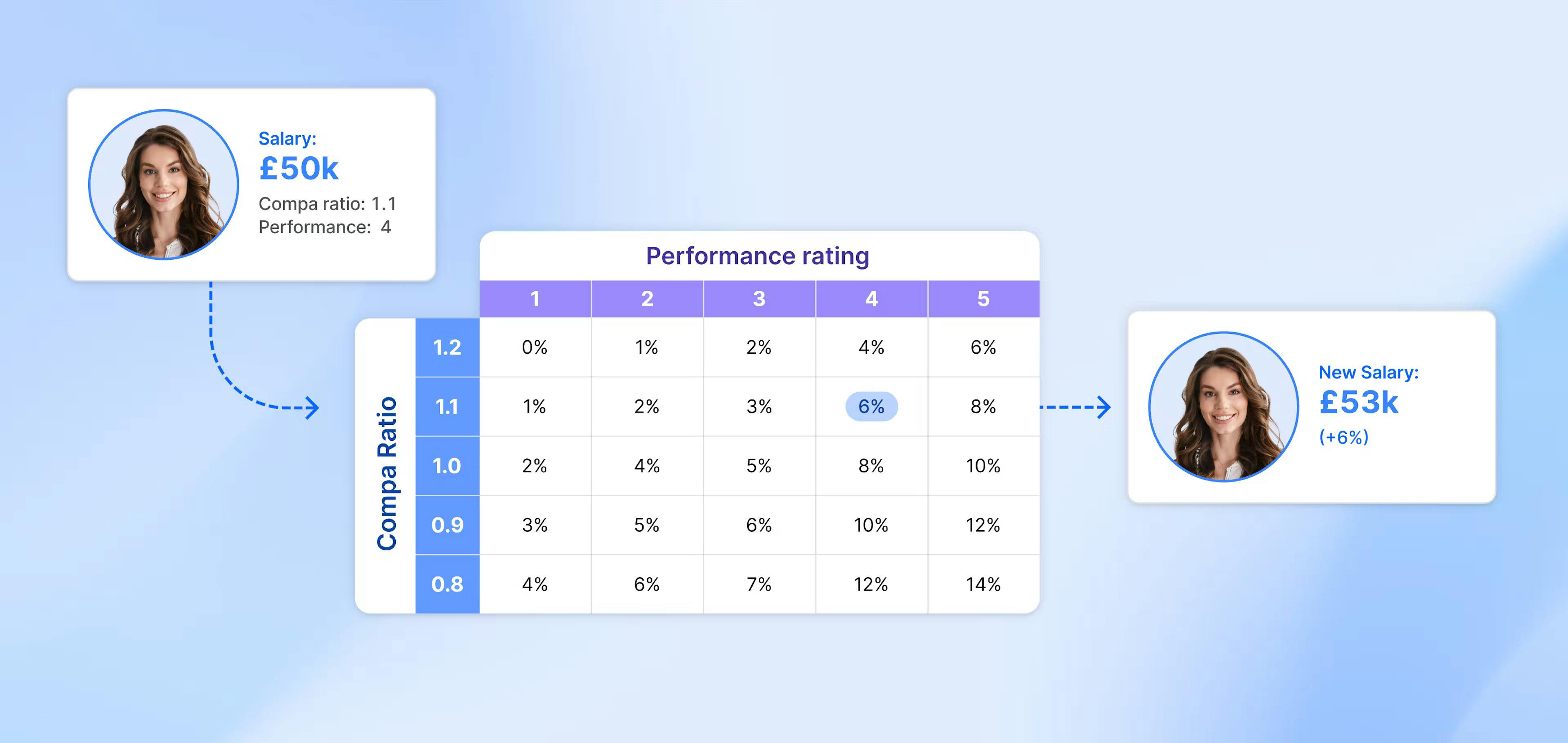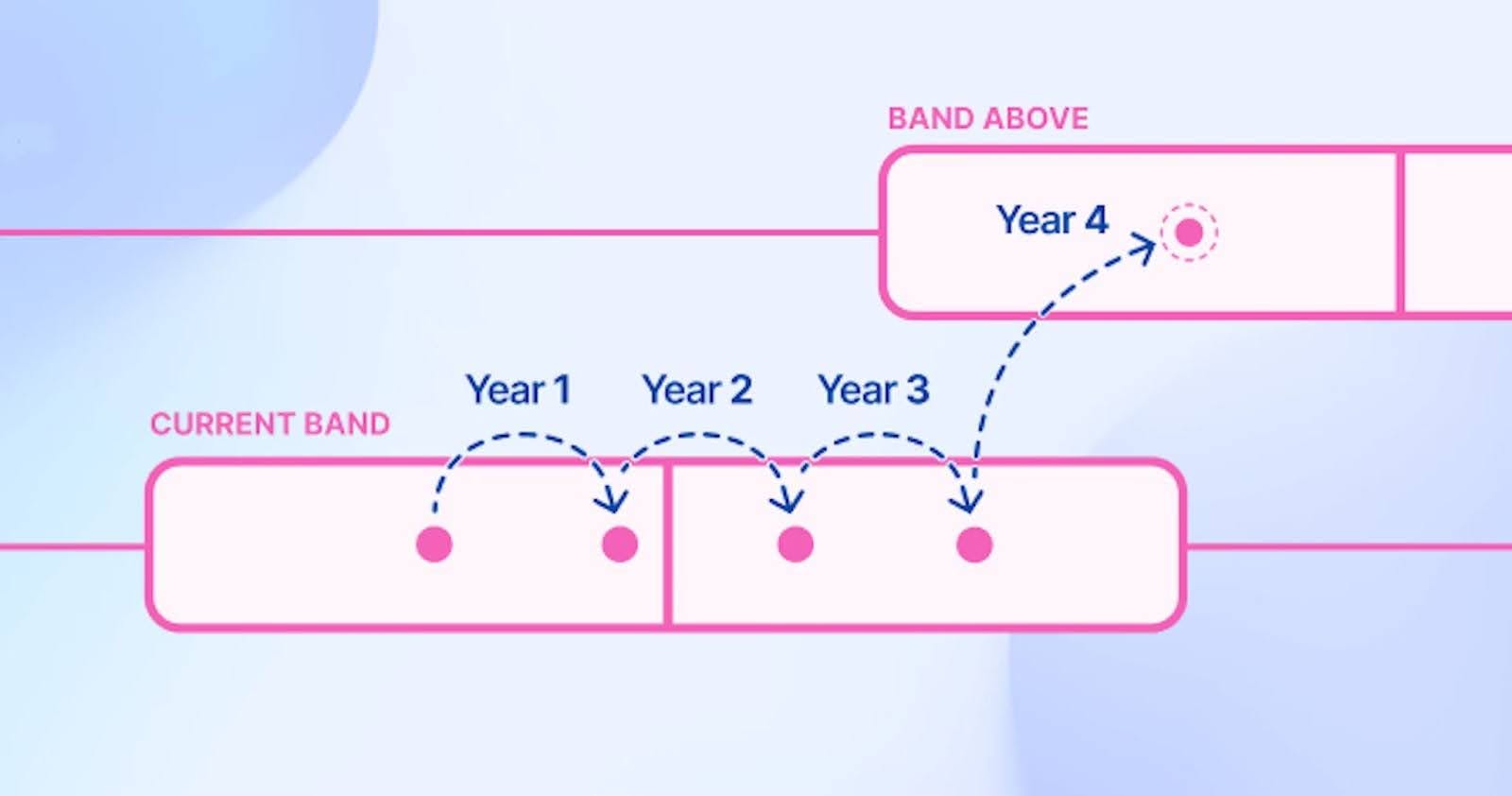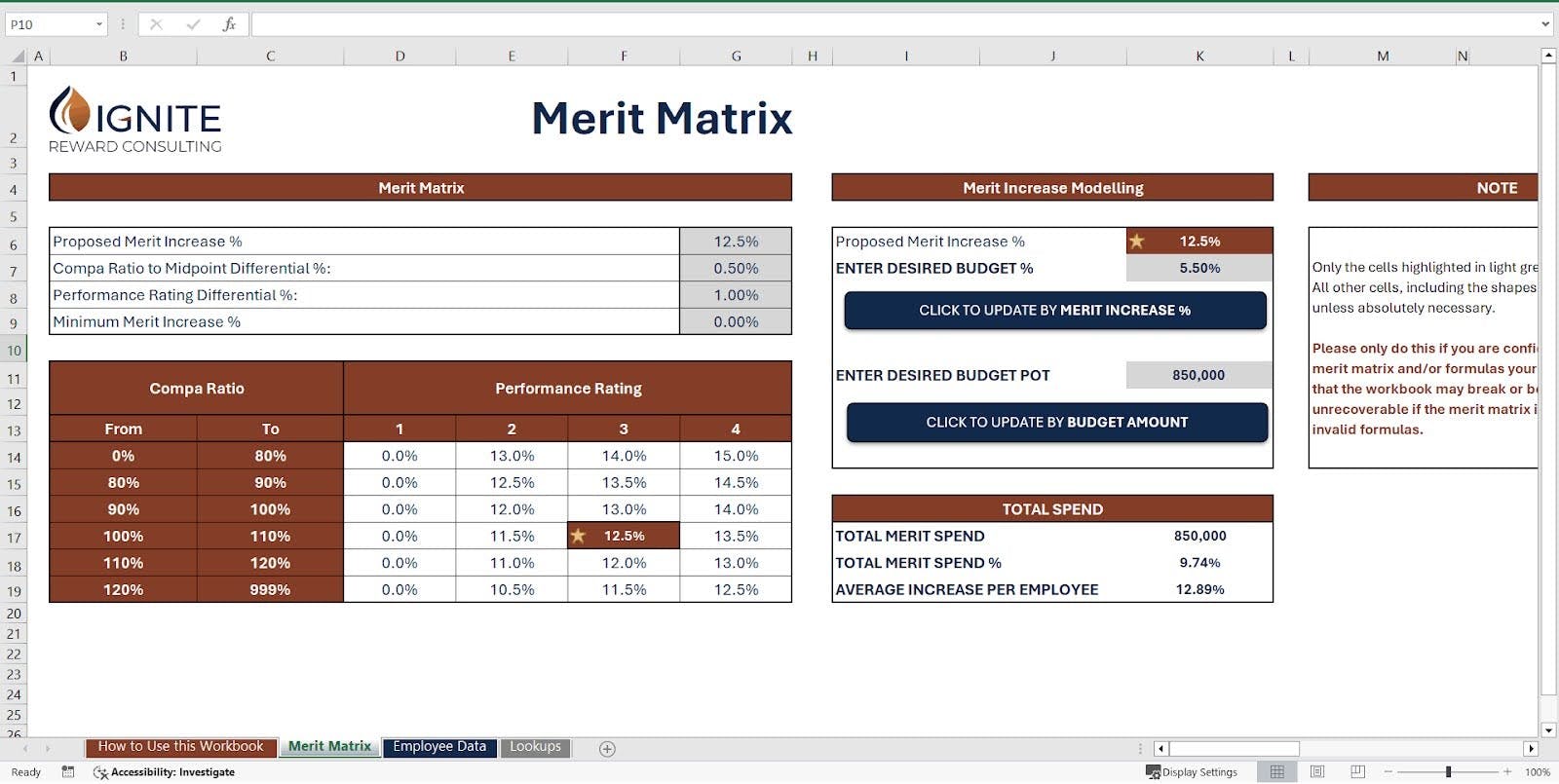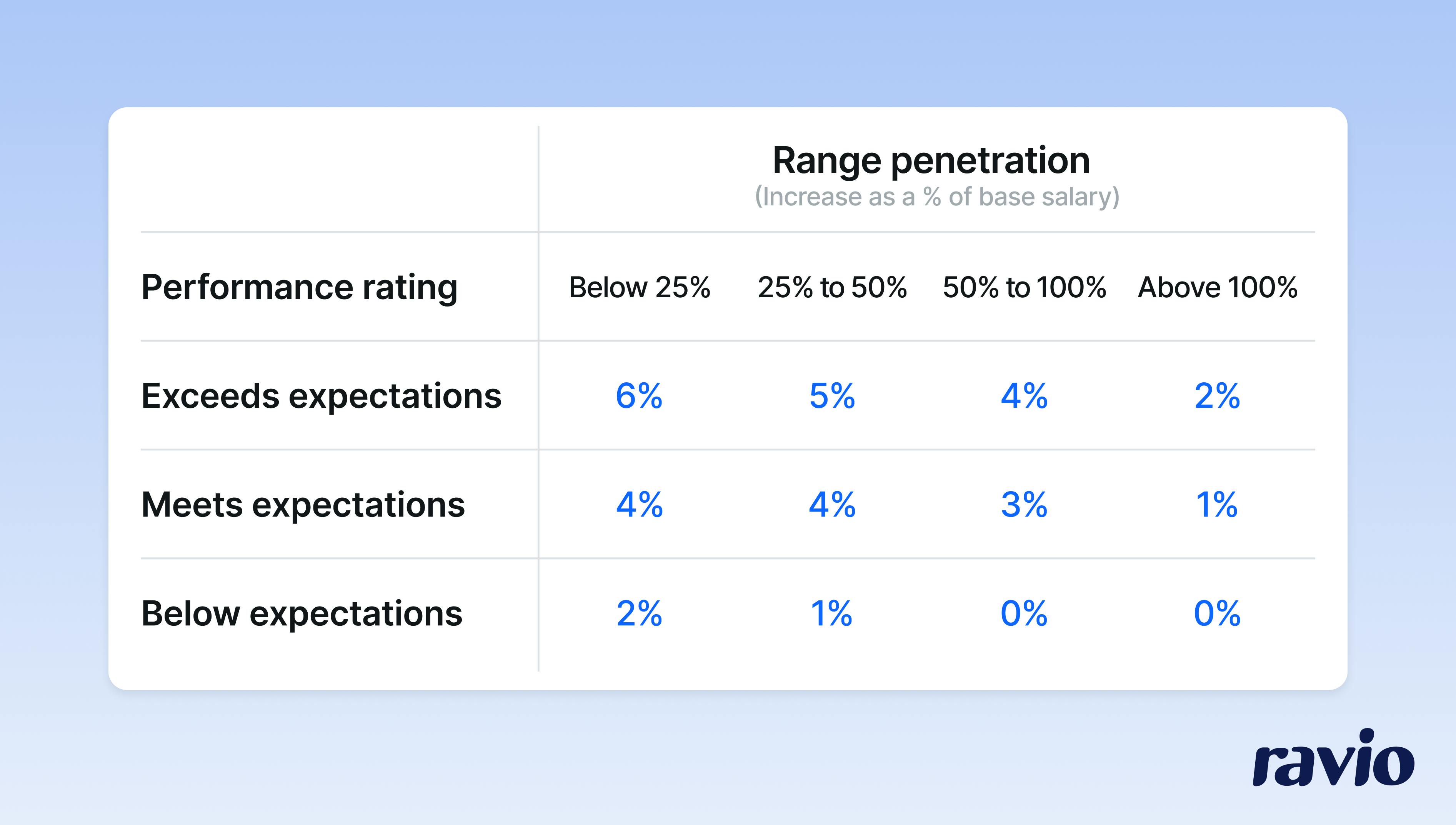- What is a merit matrix?
- How does a merit matrix work?
- Should you use a merit matrix in your compensation review?
- How popular is a merit matrix and pay for performance model?
- Different types of merit matrices
- How to create a merit matrix
- Alternatives to a merit matrix
- Conclusion: Is a merit matrix right for your organisation?
A merit matrix is a powerful tool for ensuring fairness and objectivity in a company’s compensation review process. By aligning salary adjustments with employee performance and their position within a salary band, merit matrices enable organisations to implement pay for performance models that promote equity, reduce bias, and ensure consistency.
During a compensation review, many companies adopt pay for performance to reward top performers, boost motivation, and attract and retain top talent.
However, without a structured framework like a merit matrix, linking performance reviews to salary adjustments can lead to subjectivity and pay inequities – issues that frustrate employees and complicate decision-making for managers and reward teams.
Subscribe to our newsletter for the monthly insights from Ravio's compensation dataset and network of Rewards experts 📩
What is a merit matrix?
A merit matrix is a structured framework used during compensation reviews to determine how much an employee’s pay should be adjusted. It combines two key metrics: an employee’s annual performance rating and their position within their current salary band.
Sometimes referred to as a recommendation logic or salary increase matrix, the primary purpose of a merit matrix is to provide consistent and fair compensation decisions. These adjustments consider both market-based factors (e.g. inflation or updated salary benchmarks) and individual performance. By factoring in band placement as well, it standardises pay within salary bands and aligns employees with their market-appropriate compensation levels.

By design, a merit matrix results in varied salary increases for different employees. For example, two employees may both exceed expectations in their performance reviews. However, if one is already in the top quartile of their salary band (with a higher compa-ratio, such as 1.1), they would likely receive a smaller increase than an employee positioned lower in the band (with a compa-ratio of 0.8).
By offering differentiated salary increases to employees, companies can avoid pay inequities or overpaying compared to an individual’s place within their band – which can cause salary band outliers.

For employees consistently performing at a high level but already at the top of their salary band, this often signals an opportunity for HR and Reward teams to discuss potential promotion pathways with line managers.
Instead of increasing their base salary within the same band, the focus should shift to milestones or skill development needed for a promotion to the next level. For example, if there’s a business need for a Director or Manager role, an employee exceeding their current band might be a prime candidate to progress to the band above.

Of course, manager discretion should always be a part of the final decision making process for merit increases, as they often have important context that may be useful when considering the broader picture of salary increases.
“Manager discretion is the ‘art’ side of the art and science of compensation. Managers have context that Reward teams don’t always have, and retaining that discretionary element enables ownership over the process and how it is communicated with employees.”
How does a merit matrix work?
A merit matrix can be implemented in two primary ways: through spreadsheets or by using compensation review platforms like Ravio.
Spreadsheets are often the starting point for many companies. In its simplest form, a spreadsheet-based merit matrix combines performance ratings with compensation metrics like compa-ratio or salary range penetration. Each cell in the matrix grid specifies the allocated percentage increase an employee should receive. HR and Reward teams use formulas to calculate these adjustments, ensuring alignment with performance, salary band placement, and budget.

Source: Flevy
While spreadsheets can be a flexible and cost-effective option, they require a lot of manual effort and are prone to human error, which can be difficult to detect and resolve. The process for using a spreadsheet-based merit matrix often includes:
- Manually inputting employee data into a spreadsheet
- Populating the spreadsheet with percentage increases determined by the budget
- Calculating individual adjustments manually or through formula
- Revisiting calculations if salary adjustments exceed the budget, and sometimes even restarting the process.
"As companies grow, managing compensation with spreadsheets becomes increasingly unmanageable – especially for organisations with over 500 employees. The sheer complexity and volume of data can quickly overwhelm any HR and Reward leader, which can negatively impact efficiency and decision-making when it comes to compensation.”
Should you use a merit matrix in your compensation review?
Now that we’ve covered what a merit matrix is and how it works, it’s time to address the key question: Should you include a merit matrix in your compensation review process?
If your compensation philosophy aligns with a pay for performance model – rewarding employees based on their performance and their position within a salary band – then the answer is yes. A merit matrix helps maintain fairness and consistency throughout the process, ensuring that salary adjustments reflect both employee contributions and internal pay equity.
However, if your approach to compensation focuses solely on market-based adjustments (e.g., inflation, salary benchmarks, or COLA), a merit matrix may not be essential.
While it’s still possible to use a merit matrix for market-based adjustments (e.g. assigning percentages relative to market rates rather than compa-ratios), organisations may find it more effective to reward performance through bonuses or granting equity instead of base salary adjustments.
"A merit matrix is an effective and transparent tool for rewarding performance. It simplifies the process, eliminates unnecessary noise, and provides the clarity that people value. While it can feel overly structured for smaller organisations, the positives – especially when supported by fair performance assessments – far outweigh the negatives. For companies committed to rewarding performance, a merit matrix is a valuable framework."
If you are weighing up whether to use a merit matrix, here are some reasons why one might be useful for your organisation if you are following a pay for performance model:
1. It helps your organisation remain compliant with pay equity legislation
A merit matrix is useful for organisations to align their compensation strategy with pay equity goals. This is especially important in light of the incoming EU Pay Transparency Directive, which will affect all organisations with employees based in Europe.
As of June 2026, companies with employees in Europe will need to demonstrate fairness and objectivity in their compensation decisions when it comes to gender. This includes:
- Following stricter gender pay gap reporting and being required to explain pay gaps that exist over 5%
- Being more transparent with salary ranges with job applicants in the EU, and not asking salary history from candidates
- Making pay levels and career progression pathways easily accessible for existing employees.
By incorporating a merit matrix into your compensation review process, you can effectively align performance-based adjustments, market adjustments, and pay equity objectives.
💡Looking to get prepared for the EU Pay Transparency Directive?
Read our tactical guide of all the things you need to do before the 2026 deadline
2. It keeps your organisation competitive with market rates
A merit matrix not only rewards performance but also incorporates market competitiveness by leveraging up-to-date salary benchmarking data.
Before implementing a merit matrix, it’s crucial for HR and Reward teams to refresh salary bands using the latest insights from real-time providers like Ravio. Accurate and refreshed salary bands inform key metrics such as compa-ratio or salary range penetration (an employee’s position within the band). These metrics help align pay with external market rates, reducing the risk of losing top talent to higher-paying competitors.
💡 Need accurate salary benchmarks?
Get 3 free benchmarks with Ravio to see what similar organisations are paying for the roles you’re hiring.
3. It helps correct any historical pay disparities between employees
A merit matrix also helps address historical pay disparities that may have been introduced through inconsistent hiring practices, unreliable salary benchmarking sources, or unconscious bias.
By combining performance metrics with compa-ratios, a merit matrix ensures that high-performing employees with lower compa-ratios receive larger salary adjustments. This approach gradually aligns their compensation with market standards, helping to close existing pay gaps. At the same time, high-performing employees with higher compa-ratios receive smaller increases to maintain fairness and avoid overpaying.

4. It helps to keep salary increases within your company’s payroll budget
A merit matrix ensures that salary increases remain within your organisation’s payroll budget while targeting adjustments effectively.
For instance, if a company has a payroll budget of £1,000,000 and a merit increase allocation of £33,000 (3.3%), the matrix distributes these funds strategically. Employees with strong performance and lower placement in their salary band receive larger increases, while those with higher placement or lower performance ratings receive smaller adjustments. This approach ensures budget equity and efficiency while rewarding performance appropriately.
5. Minimise regrettable attrition
By providing salary increases to top performers who are lower in their band, a merit matrix helps keep their compensation competitive with market standards, reducing the risk of losing valuable talent to competitors.
Not only this, but competitive salary adjustments can help to reinforce employee engagement and retention by demonstrating that the organisation recognises and values their contributions. High performers feel incentivised to stay, while the matrix's structured framework ensures fairness across the board, balancing retention with budgetary control.
How popular is a merit matrix and pay for performance model?
Data from Ravio’s 2025 Compensation Trends report highlights that a pay for performance model is widely adopted across European tech companies – with 79% of companies using performance ratings in one way or another to guide salary increases. Of these, 41% base adjustments solely on performance, while another 38% incorporate both performance and inflation.

For the 38% of companies blending performance and market-based adjustments, a merit matrix can be an invaluable tool to streamline the compensation review process and ensure fairness.
However, despite its benefits, Ravio’s research also reveals a near-even split in adoption – with 49% of companies using merit matrices and 51% opting for alternative methods.

This division highlights the ongoing debate in the HR and Reward community about the effectiveness of merit matrices. While some view them as essential for maintaining equity and structure, others argue that alternative approaches better align with their organisational needs.
Below are perspectives from both sides of the conversation, illustrating the advantages and challenges of adopting a merit matrix.
Against pay for performance models:
“Adjusting base salaries for performance can create internal pay equity challenges, making it hard to distinguish between competitive market rates and performance-based increases. Performance is better rewarded through variable pay or equity, with high performers naturally earning promotions that come with salary increases. Base salary adjustments during comp reviews should focus solely on aligning with market benchmarks to ensure fairness and competitiveness.” - Becky Brawn, People Partner, People Collective
For pay for performance models:
“Instead of focusing on past performance, our annual salary review looks ahead, considering skills, experience, and how an employee's pay compares to the market to stay competitive. By paying for past performance you are paying for that forever as it is consolidated into base, whereas by paying for performance via bonus, this is just for that year. This leads to more fairness and consistency. - Tanya Krasnova, Senior Reward and Benefits Manager at Pipedrive
Different types of merit matrices
There are two types of merit matrices that companies can use.
1. Performance + compa-ratio merit matrix
This approach combines employee performance ratings with their compa-ratio, a metric that compares an employee’s salary to the midpoint of their salary band. For example:
- If an employee’s salary matches the midpoint of their band, their compa-ratio is 1.0.
- If their salary is 20% above or below the midpoint, their compa-ratio is 1.2 or 0.8, respectively.

The performance + compa-ratio merit matrix is the most commonly used because it strikes a balance between rewarding performance and maintaining market competitiveness. By linking salary adjustments to both performance and an employee’s position within their salary band, it reduces risks like salary compression and pay inequities.
This model is particularly popular among startups and mid-sized companies operating in competitive industries like tech, where keeping pace with salary benchmarks is essential for retaining and attracting top talent.
2. Performance + salary range penetration (or position in the band) merit matrix
This model closely resembles the compa-ratio merit matrix but focuses on an employee’s position within their entire salary range.
For example, let’s calculate an employee’s position within their salary band:
- Current salary: £50,925
- Band minimum: £42,500
- Band maximum: £57,500
Using this approach, the employee is 56% of the way through their band.

This model is particularly useful for companies aiming to accelerate pay adjustments for employees at the lower end of their salary band while slowing increases for those closer to the top. This might be required if companies must close the pay gap quickly, perhaps in the light of incoming EU Pay Transparency legislation.
How to create a merit matrix
Whether you’re building your merit matrix in an Excel spreadsheet or using a compensation review platform, following these steps will ensure it aligns with your organisation’s compensation philosophy.
Step 1: Define performance metrics
Start by identifying clear, measurable performance criteria that align with your company’s goals. Use a standardised rating system (e.g. 1 to 5) to assess employee performance consistently across teams. Tie these metrics to tangible outputs and behaviours that reflect both individual contributions and broader company objectives.
Step 2: Establish or refresh salary bands and calculate compa-ratios
Ensure your salary bands are up-to-date and competitive with the market by leveraging recent salary benchmarking data. This step is critical – stale salary bands can lead to inequities or misaligned adjustments with the external market.
Once your bands are refreshed, calculate key metrics like:
- Compa-ratio: Divide an employee’s salary by the midpoint of their band to gauge their positioning against the market.
- Salary range penetration: Determine how far along the salary band an employee’s pay falls, relative to the minimum and maximum values.
"Building a successful reward program is a multi-stage process that starts with aligning on key criteria with stakeholders. Consider how much manager discretion to allow, the importance of maintaining pay equity, and whether to stick rigidly to salary bands—even if it risks losing candidates. Take a holistic view of rewards, including your benefits package, and think about the behaviors you want to incentivise. Clear priorities and alignment are essential for success."
Step 3: Develop your merit matrix (or use a platform like Ravio)
Create a grid that integrates performance ratings on one axis and compa-ratios (or an employee’s salary band position) on the other. Assign percentage increase guidelines for each cell to balance performance recognition, pay equity, and market alignment.
- High performers with low compa-ratios: Assign higher percentage increases to bring them closer to the market midpoint.
- High performers with high compa-ratios: Offer smaller increases to maintain equity without exceeding salary band limits.
- Average performers: Adjust pay incrementally based on both their performance and position in the band.

Step 4: Test scenarios against budget constraints
Run multiple scenarios to project the outcomes of your merit matrix. Validate whether the proposed increases fit within your compensation review budget while achieving equity and performance goals. Adjust percentage ranges if necessary to align with financial constraints, ensuring fairness is not compromised.
‼️ Note: This is a lot of work to do manually through spreadsheets, and it’s where platforms like Ravio become indispensable as they allow you to see your budget and total spend based on different scenarios in one dashboard view.

Step 5: Communicate and train up managers
While managers don’t need to understand every detail of the matrix’s inner workings, they should be able to explain the rationale behind the salary adjustment recommendations generated by the merit matrix.
By providing managers with clear guidance on how performance and market position influenced an individual's compensation adjustments, they’ll be better equipped to address any questions and ensure transparency during the compensation review process.
💡 Why Pipedrive stopped adjusting base salaries for top-performers as they scaled
Pipedrive is a sales CRM and pipeline management tool. Pipedrive was founded in Estonia in 2010, and has since grown into a company with 1,000 employees currently.
As Pipedrive’s headcount increased, the decision was made to separate salary increases from performance ratings. Instead, Pipedrive shifted to a “market-driven pay” approach, using the compensation review period to bring salaries in line with up-to-date salary benchmarks, whilst also conducting an analysis of compa ratios and internal pay equity. The aim is to ensure that employee pay always remains fair and competitive.
As Tanya Krasnova, Senior Reward and Benefits Manager at Pipedrive, puts it:
“Instead of focusing on past performance, our annual salary review looks ahead, considering skills, experience, and how an employee's pay compares to the market to stay competitive.”
This focus on eliminating internal pay equity issues is becoming increasingly important “given the growing regulatory scrutiny” as new laws like the EU Pay Transparency Directive approach – Pipedrive’s approach ensures that company-wide consistency is maintained.
Pipedrive does still use the ‘pay for performance’ model though, just not for base salaries. Instead, performance is rewarded through an annual bonus plan and commission scheme.
“By paying for past performance you are paying for that forever as it is consolidated into base, whereas by paying for performance via bonus, this is just for that year. This leads to more fairness and consistency.”
High-performers are also encouraged to take on additional responsibilities, train on new skills, or test out other job roles outside of their discipline – helping them to reach the next level of promotion more quickly. Plus, a recognition platform means that employee achievements are constantly being highlighted.
As well as ensuring fair and competitive pay, the shift has also been great for employee communication: “For employees, it means they don’t have to rely solely on annual reviews for recognition – they know they can expect fair and consistent salary reviews along with other growth opportunities.”
Alternatives to a merit matrix
While merit matrices are a widely used method for managing performance-based salary adjustments, they’re not the only approach to structuring compensation. Depending on your organisation’s needs, compensation philosophy, and focus areas, there are several alternatives to consider.
1. Market-based adjustments only
Market-based adjustments focus solely on aligning employee salaries with external market rates, prioritising market competitiveness and fairness across roles and locations without considering individual performance.
Organisations relying on market-based adjustments use up-to-date salary data – through salary benchmarking tools – to review and revise salaries. While this method ensures alignment with market standards, performance can still be rewarded separately through bonuses or other incentives.
2. Full manager discretion on salary adjustments
In this approach, managers are given a budget and broad guidelines by HR to allocate salary increases based on their assessment of their direct reports' contributions.
This method enables tailored rewards for unique situations, critical roles, or high-performing employees who may not fit neatly into a structured model like a merit matrix. However, it requires consistent manager training and calibration sessions to mitigate risks of bias, inconsistency, or favouritism. This approach is best suited for organisations with strong management training processes and confident leadership capabilities.
3. Company-wide salary increase
A simpler alternative is applying uniform salary increases across employees based on pre-defined criteria. For example, all employees receiving a top performance rating (e.g. 5 on a 1 - 5 scale) could receive a 5% raise, regardless of their position within their salary band or alignment with salary benchmarks.
While this method ensures consistency and simplifies the process, it may lack the nuance needed to address pay equity or retain competitiveness in the market.
4. 9-box grid (another dimension of a merit matrix)
The 9-box grid can be considered an additional dimension to a merit matrix, offering insights into employee potential alongside performance and band placement.
As a talent management tool, the 9-box grid evaluates employees based on both their current performance and future potential, categorising them into nine "boxes" across these two dimensions. Traditionally used for talent development and succession planning, the 9-box grid can complement a merit matrix by adding a "potential" rating to the mix.
According to Rob Green, Global Rewards Consultant, Founder of Darwin Total Rewards, and an Associate within the MCR Consulting group, the 9-box grid “demonstrates organisational and leadership maturity when all three elements are working together effectively.”

Conclusion: Is a merit matrix right for your organisation?
A merit matrix is a powerful tool for ensuring fair and transparent compensation practices, particularly in dynamic industries like tech. By aligning pay adjustments with employee performance, budget constraints, and market trends, a merit matrix helps organisations stay competitive while rewarding employees equitably.
If you’re ready to implement a merit matrix, start by evaluating your current compensation strategy, defining measurable performance metrics, and updating your salary bands using the latest salary benchmarking data.



